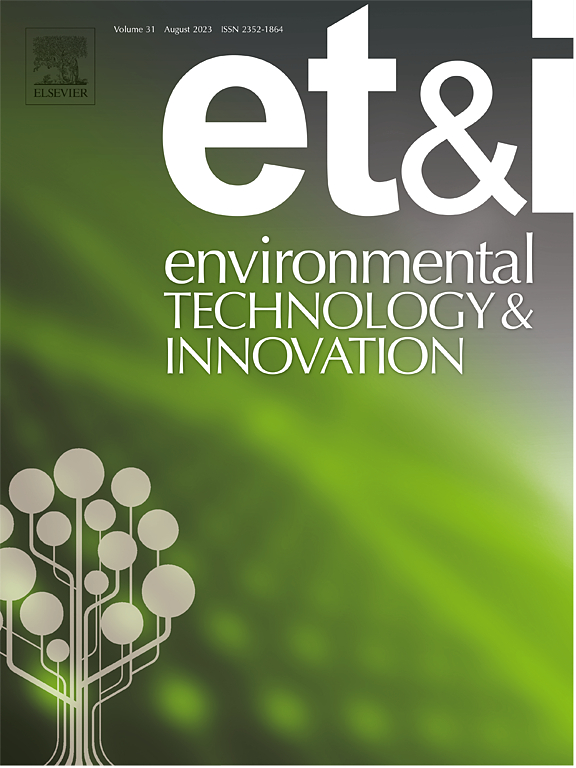利用微生物-纳米粒子协同作用提高废水灌溉含盐镉污染土壤的水稻产量
IF 6.7
2区 环境科学与生态学
Q1 BIOTECHNOLOGY & APPLIED MICROBIOLOGY
引用次数: 0
摘要
土壤盐分和镉污染对农业生产力和粮食安全构成重大威胁,特别是在水稻种植区。本研究探讨了植物促生根瘤菌(PGPRs)(韩国假单胞菌、凝固芽孢杆菌和stutzeri假单胞菌)和硒纳米颗粒(SeNPs)在修复含盐镉污染土壤和提高水稻生产性能中的协同作用。在连续两个生长季节(2022-2023),PGPRs和SeNPs的联合施用显著改善了土壤健康,将土壤pH从8.50降低到8.02,电导率(ECe)从5.97降低到4.01 dS m⁻¹ ,同时使土壤有机质(SOM)增加6.5 %,阳离子交换容量(CEC)增加25.6 %。该处理还使土壤Cd含量降低34.6% %,从0.81降低到0.53 mg kg⁻¹ ,并使水稻根、芽和种子的Cd积累量分别降低56.7% %、65.0% %和50.0% %,确保了更安全的稻米生产。此外,SeNPs显著提高了水稻幼苗和种子中的硒含量,幼苗中的硒含量从0.55 μ g g−1增加到1.47 µg g−1,种子中的硒含量从0.01 μ g g−1增加到0.51 µg g−1,显示了SeNPs对水稻营养品质的改善作用。生理分析表明,联合处理提高了光合色素浓度,叶绿素a增加了112.3 %,类胡萝卜素增加了213.6 %,超氧化物歧化酶(SOD)活性增加了101.9 %。这些改进使粮食产量增加了25.0 %,从5.76吨增加到7.24吨(⁻¹ ),千粒重增加了21.4% %。研究结果表明,在盐镉联合胁迫下,PGPRs和SeNPs具有减轻氧化胁迫、改善养分吸收、降低Cd毒性和提高水稻产量的作用。该研究为污染环境下的可持续土壤修复和作物生产提供了一种新颖的、生态友好的策略,对全球粮食安全和农业可持续性具有重要意义。本文章由计算机程序翻译,如有差异,请以英文原文为准。
Enhancing rice productivity in wastewater-irrigated saline Cd-contaminated soils using microbial-nanoparticle synergy
Soil salinity and cadmium (Cd) contamination pose significant threats to agricultural productivity and food security, particularly in rice-growing regions. This study investigates the synergistic effects of plant growth-promoting rhizobacteria (PGPRs) (Pseudomonas koreensis, Bacillus coagulans, and Pseudomonas stutzeri) and selenium nanoparticles (SeNPs) in remediating saline Cd-contaminated soils and enhancing rice (Oryza sativa L.) performance. Over two consecutive growing seasons (2022–2023), the combined application of PGPRs and SeNPs significantly improved soil health, reducing soil pH from 8.50 to 8.02 and electrical conductivity (ECe) from 5.97 to 4.01 dS m⁻¹ , while increasing soil organic matter (SOM) by 6.5 % and cation exchange capacity (CEC) by 25.6 %. The treatment also reduced soil Cd content by 34.6 %, from 0.81 to 0.53 mg kg⁻¹ , and decreased Cd accumulation in rice roots, shoots, and seeds by 56.7 %, 65.0 %, and 50.0 %, respectively, ensuring safer rice grain production. Furthermore, SeNPs significantly enhanced selenium (Se) content in rice shoots and seeds, with Se levels increasing from 0.55 to 1.47 µg g−1 in shoots and from 0.01 to 0.51 µg g−1 in seeds, highlighting their role in improving rice nutritional quality. Physiological analyses revealed enhanced photosynthetic pigment concentrations, with chlorophyll a increasing by 112.3 % and carotenoids by 213.6 %, alongside a 101.9 % increase in superoxide dismutase (SOD) activity under the combined treatment. These improvements translated into a 25.0 % increase in grain yield, from 5.76 to 7.24 ton ha⁻¹ , and a 21.4 % increase in 1000-grain weight. The findings highlight the efficacy of PGPRs and SeNPs in mitigating oxidative stress, improving nutrient uptake, reducing Cd toxicity, and enhancing rice productivity under combined salinity and Cd stress. This study provides a novel, eco-friendly strategy for sustainable soil remediation and crop production in contaminated environments, offering significant implications for global food security and agricultural sustainability.
求助全文
通过发布文献求助,成功后即可免费获取论文全文。
去求助
来源期刊

Environmental Technology & Innovation
Environmental Science-General Environmental Science
CiteScore
14.00
自引率
4.20%
发文量
435
审稿时长
74 days
期刊介绍:
Environmental Technology & Innovation adopts a challenge-oriented approach to solutions by integrating natural sciences to promote a sustainable future. The journal aims to foster the creation and development of innovative products, technologies, and ideas that enhance the environment, with impacts across soil, air, water, and food in rural and urban areas.
As a platform for disseminating scientific evidence for environmental protection and sustainable development, the journal emphasizes fundamental science, methodologies, tools, techniques, and policy considerations. It emphasizes the importance of science and technology in environmental benefits, including smarter, cleaner technologies for environmental protection, more efficient resource processing methods, and the evidence supporting their effectiveness.
 求助内容:
求助内容: 应助结果提醒方式:
应助结果提醒方式:


